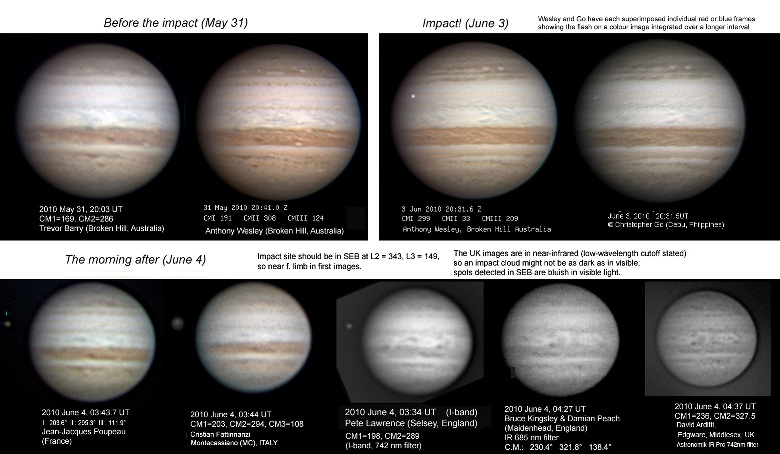
[2] A new impact on Jupiter (June 5th, 2010.)
A New impact on Jupiter
A new impact has been detected on Jupiter. This time the impact flash was
recorded directly, by two independent amateur observers. It was first reported
by Anthony Wesley (Australia) (who discovered the impact last year), and
confirmed by Chris Go in a video taken at exactly the same time: 2010 June 3,
20:31:29UTC. It was a very bright flash lasting about 2 seconds, so there
can be no doubt that it was an impact; no internal event in Jupiter would
produce such a bright brief flash.
It was in the faded South Equatorial Belt, about 50 deg. preceding the central
meridian; Wesley's preliminary measurements put it at Longitude L2 = 342.7, L3 =
159.4, Latitude 16.1 deg.S.
Nothing further was seen at the impact site in the half-hour before it
disappeared round the limb. When it reappeared, this morning around 03:30 UT ,
observers in England, France and Italy looked for an impact spot but recorded
nothing definite. However, the images were at low resolution (due to the low
altitude and bright dawn sky), so the images do not exclude a smaller scar.
Observations of this site over the next few days will be very important.
Even if no 'scar' is detected, this would not be surprising. The direct imaging
of the SL9 impacts in 1994 by the Galileo spacecraft showed a bright flash a few
seconds long like this one even for a small fragment which produced virtually no
scar, probably because a small impactor can explode high in the atmosphere.
So, impacts like this could be frequent, but never before recorded, and still
consistent with the rarity of larger impacts that leave obvious traces. By the
way: Uranus is 0.5 degrees north of Jupiter at present: a good opportunity
to compare the two giant planets.
Images taken before, during and after the impact are attached. Note that
there are a few faint blue-grey spots in this region of the SEB, which show up
dark in the infrared images; these are not impact-related. Thanks to Pete
Lawrence, Bruce Kingsley with Damian Peach, David Arditti, Cristian Fattinnanzi,
Jean-Jacques Poupeau, & Fabio Carvalho (similar IR image just posted), for
this morning's images. Did Spanish observers get anything?
Anthony and Chris are posting images and videos on their web sites, and a resume
was given in a news bulletin already:
http://arstechnica.com/science/news/2010/06/breaking-news-jupiter-hit-by-yet-another-impactor.ars
If this is indeed a small impact which doesn't leave a scar, I wonder if they
have ever been seen before. This is the first direct ground-based
observation of an impact fireball on any planet that I know of. Old-time
visual observers would perhaps never have mentioned such a flash as it could not
be recorded nor confirmed. This time both Anthony and Chris were recording
routine videos to produce images, and caught it. Regular imagers: how many
minutes/hours per night do you typically record? Do you look thru all of
it??
Whether or not there is a scar, this is a very important observation, and from
Anthony's and Chris's videos it should be possible to measure the light-curve,
and compare it with those of the SL9 fragments from Galileo. Also, Chris points
out that his video may show an elongated entry track and further structure.
A fantastic achievement by both of them!
best wishes,
John
______________________________________
John H. Rogers, Ph.D.
Jupiter Section Director,
British Astronomical Association.
Click below for full size image.